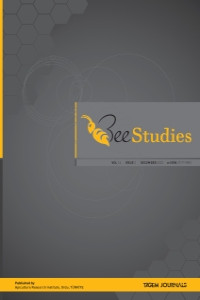Öz
The genetic structure and diversity of Apis mellifera from eight populations across two
vegetational zones of Nigeria was investigated in order to provide base line
information that will enhance its conservation, genetic improvement and sustainable
yield. Genomic DNA was extracted from 40 specimens randomly selected from eight
colonies in derived savannah and tropical rainforest regions of Nigeria. The specimens
were amplified using five Random Polymorphic DNA (RAPD) primers and the amplicons
generated were assessed using appropriate statistical indices. Results generated
revealed significant genetic polymorphisms among the eight populations of A.
mellifera ranging from 38.89 to 68.52% with a total of 281 bands amplified from 54
loci in all samples. The derived savannah population (Offa) had a greater amount of
genetic diversity than the rest seven (7) populations as revealed by the percentage of
polymorphic loci, expected heterozygosity and Shannon information index (I). The
genetic structure as revealed by the Neighbour-Joining dendrogram showed that the
eight populations studied represent two major genotypic groups with intra-group
relationships. Eleyoka and Offa populations were the genetically closest in the first
group while Ayetoro-Gbede and Ayegunle-Gbede populations were the genetically
closest in the second group. The study suggests that the two major genotypic groups
represent two distinct genetic stocks and can thus be managed accordingly.
Anahtar Kelimeler
Ayrıntılar
| Birincil Dil | İngilizce |
|---|---|
| Konular | Ziraat, Veterinerlik ve Gıda Bilimleri, Veteriner Cerrahi |
| Bölüm | Research Articles |
| Yazarlar | |
| Yayımlanma Tarihi | 30 Aralık 2022 |
| Gönderilme Tarihi | 26 Ekim 2022 |
| Yayımlandığı Sayı | Yıl 2022 Cilt: 14 Sayı: 2 |

